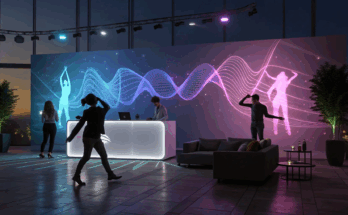In reaction to the commercialization of disco & a desire for experimental sound, Electronic Dance Music (EDM) emerged in the underground rave scene of the 1980s. DJs and producers made music with hypnotic rhythms and repeating beats by using drum machines, synthesizers, and other electronic instruments. Earlier EDM parties frequently took place in unusual settings, such as deserted warehouses, which encouraged free musical expression.
Key Takeaways
- EDM originated from underground raves in the 1980s and has since become a mainstream success, with artists like Daft Punk and The Chemical Brothers leading the way.
- EDM has transcended cultural boundaries, becoming a global phenomenon with artists and fans from all over the world embracing the genre.
- EDM festivals like Ultra and Tomorrowland have become massive events, attracting thousands of fans and showcasing the biggest names in electronic music.
- Technology has played a significant role in the evolution of EDM, from the use of vinyl in the early days to the digital revolution that has transformed the production and distribution of music.
- Social media has been instrumental in the spread of EDM, allowing artists to connect with fans and promote their music on a global scale.
- EDM has evolved into various subgenres, and its crossover with pop music has led to the creation of chart-topping hits and collaborations with mainstream artists.
- The future of EDM is filled with trends and innovations, including the incorporation of virtual reality, AI, and new production techniques that will continue to push the boundaries of electronic dance music.
Through their chart-topping success & electrifying live performances, EDM artists like The Prodigy, Fatboy Slim, and Daft Punk helped bring the genre into the mainstream in the 1990s. House, techno, trance, and other electronic music genres have all influenced the genre’s evolution. EDM had become a worldwide phenomenon by the early 2000s, with specialized festivals & club nights springing up all over the world. Its upbeat vibe and capacity to bring people together on dance floors are the reasons behind EDM’s popular success.
Younger generations looking for alternatives to mainstream music were drawn to its edgy, rebellious appeal because of its underground beginnings. The possibilities of electronic music have expanded as a result of technological advancements that have allowed producers to produce sounds that are more intricate and inventive. EDM has managed to stay a major force in popular music thanks to its innovative and approachable approach. EDM Festivals: An International Trend. Further confirming EDM’s status as a truly global movement is the growth of festivals like Tomorrowland in Belgium & Ultra Music Festival in Miami.
Due to its universal appeal and capacity to unite people via the power of music, EDM has had a significant global impact. People can connect with EDM on a primal level, regardless of language or cultural background, and it inspires them to dance, celebrate, & let loose. A New Wave of EDM Performers. Its ascent to popularity in nations like the US, the UK, and Australia has opened doors for a new wave of EDM musicians from around the world to establish themselves on the global scene. Popular culture in other domains, such as fashion, cinema, & advertising, has also been influenced by EDM. Its hugely influential productions and throbbing rhythms have spurred fresh ideas and inventiveness in these fields, solidifying its position as a major force in world culture.
EDM’s Future. In the years to come, EDM’s influence on popular culture is probably only going to get bigger as it keeps getting better and reaching new audiences. The popularity of EDM festivals has been a major factor in the genre’s rise to mainstream recognition.
Gathering hundreds of thousands of fans from all over the world to celebrate their love of electronic music, these epic events have come to represent the EDM experience. EDM fans now consider festivals like Tomorrowland in Belgium, Electric Daisy Carnival in Las Vegas, and Ultra Music Festival in Miami to be must-attend events because they provide an immersive experience that goes well beyond just the music. Some of the biggest names in EDM are present at these festivals, along with up-and-coming performers who are stretching the boundaries of the genre. Lineups are frequently varied and eclectic, presenting a broad spectrum of EDM styles and subgenres. Along with the music, these festivals provide attendees with an otherworldly experience thanks to their intricate stage designs, cutting-edge sound systems, & astounding visual effects.
In addition to giving musicians a stage on which to display their abilities, the popularity of EDM festivals has forged a bond between followers. These get-togethers create a space for people who love electronic music to come together, dance, connect, and celebrate their shared passion. They attract people from all walks of life. The influence of these festivals, which have become a crucial component of the global EDM experience, will only increase as EDM’s appeal grows. One cannot emphasize the impact of technology on EDM.
Technology has had a significant influence on the sound and culture of electronic dance music, from its beginnings as an underground movement to its current position as a worldwide phenomenon. DJs used turntables & vinyl records in the early days of electronic dance music (EDM) mixing and manipulation. The art of DJing emerged from this analog method, where competent people could combine their hands and ears to produce smooth transitions between tracks. The instruments available to EDM producers and DJs expanded along with technology.
Musicians were able to experiment with new sounds and textures in ways that were previously unattainable with the advent of digital audio workstations (DAWs) and software synthesizers, which completely changed the way music was made. The development of digital DJ equipment also made it simpler for artists to tinker with music in real time, allowing them to incorporate more spontaneity and creativity into their performances. EDM’s production values and live performances are further examples of how technology has affected the genre.
Modern lighting & sound setups are now commonplace at EDM events, giving guests an immersive visual experience. In addition, artists are pushing the limits of what is conceivable in live entertainment by utilizing cutting-edge technologies like augmented reality and virtual reality. Technology’s influence on EDM will grow as it does, reshaping the genre in novel & fascinating ways for years to come. The globalization of EDM has been greatly aided by social media.
Fans may now interact with their favorite musicians & with each other on social media sites like Facebook, Twitter, Instagram, and YouTube, fostering a sense of community that knows no geographical bounds. In addition, social media has given artists the opportunity to reach a worldwide audience with their music and performances, which has helped them develop a devoted following and increase their visibility outside of conventional media. Social media has not only helped artists and fans connect, but it has also greatly aided in promoting EDM festivals and events. To reach potential attendees and generate excitement for their events, organizers can employ influencer partnerships and targeted advertising. Fans who are unable to attend in person can now experience the magic from a distance thanks to social media platforms’ role as a central location for sharing festival highlights and live streaming.
One cannot stress how important social media was in the EDM movement’s spread. The genre’s ascent to popularity has been largely attributed to its capacity to unite individuals from all over the world and enable the sharing of experiences and music. The influence of social media on EDM will grow as it does, offering new ways for both fans and artists to interact & communicate.
EDM’s diversification. Several subgenres that have emerged to broaden the sonic palette & appeal of EDM have marked the genre’s evolution. Each subgenre, which includes house, techno, dubstep, and trap, adds distinctive qualities and influences to the mix, resulting in a varied tapestry of sounds under the larger heading of electronic dance music. Artists have been able to push the limits of what is possible in electronic music and experiment with new styles thanks to these subgenres. Crossover with Pop Music.
Pop musicians like David Guetta, Avicii, & Calvin Harris have achieved mainstream success with their chart-topping hits, leading to a crossover between EDM and pop in recent years. Blurring the boundaries between commercial pop music and underground dance culture, this fusion of pop & electronic sensibilities has made EDM accessible to a wider audience. Consequently, EDM has emerged as a major force in popular music, impacting everything from lineups at festivals to radio airplay. The Electronic Dance Music of the Future.
EDM is still evolving, with artists constantly pushing the envelope and discovering new sonic realms. Subgenres that offer new takes on electronic music that appeal to a younger audience, such as future bass, tropical house, and future house, have become more popular in recent years. EDM is going to be a major force in music for years to come, and as it develops, so too will its influence on popular culture. A number of developments & trends seem certain to reshape the EDM genre in novel and intriguing ways as we move forward.
The popularity of augmented reality (AR) & virtual reality (VR) experiences at live events is one such trend. Artists are experimenting with different approaches to integrate these technologies into their performances, building immersive environments that take viewers to new realms. The ongoing crossover of EDM with other genres and styles is another trend that will probably influence the genre’s future. Expect more crossover collaborations between EDM musicians and musicians from other genres, such as hip-hop, rock, & RandB, as electronic music continues to have a significant cultural impact. The possibilities for music will be expanded by this blending of styles, resulting in brand-new auditory environments.
Innovation-wise, EDM’s future is probably going to be greatly influenced by developments in artificial intelligence (AI). Producers can now create new sounds & compositions with AI-powered tools, opening up previously unthinkable levels of creativity and experimentation. We may anticipate that as AI develops further, a large number of EDM artists will use it exclusively in their creative processes. In summary, EDM has a promising future.
Electronic dance music, with its origins in underground rave culture and its capacity to cross cultural barriers, has grown to become a global phenomenon that is constantly innovating. EDM is likely to stay at the forefront of popular culture for some time to come as new trends and technological advancements take hold.
If you’re interested in the latest music trends, you should check out the re-launch of Music Charts 24. This website provides up-to-date information on the top music charts, including the latest hits in electronic dance music. It’s a great resource for staying informed about the music industry and discovering new artists and songs.
FAQs
What is Electronic Dance Music (EDM)?
Electronic Dance Music (EDM) is a genre of music that is primarily produced for dance-based entertainment in nightclubs, festivals, and raves. It is characterized by its use of electronic instruments and a repetitive beat.
How did EDM become popular worldwide?
EDM’s rise to popularity can be attributed to a combination of factors, including the globalization of music, the rise of social media, and the increasing popularity of music festivals and events.
What are some popular subgenres of EDM?
Some popular subgenres of EDM include house, techno, trance, dubstep, drum and bass, and trap. Each subgenre has its own distinct sound and characteristics.
What role did DJs and producers play in the EDM explosion?
DJs and producers have played a crucial role in the rise of EDM, as they are the ones creating and performing the music that has captivated audiences around the world. Many EDM artists have become global superstars and have helped to popularize the genre.
How has EDM impacted the music industry?
EDM has had a significant impact on the music industry, influencing the sound of popular music and leading to collaborations between EDM artists and mainstream pop and hip-hop artists. It has also led to the growth of music festivals and events dedicated to electronic music.
What are some of the biggest EDM festivals in the world?
Some of the biggest EDM festivals in the world include Tomorrowland in Belgium, Ultra Music Festival in Miami, Electric Daisy Carnival (EDC) in Las Vegas, and Creamfields in the UK. These festivals attract thousands of attendees from around the world and feature performances from top EDM artists.



